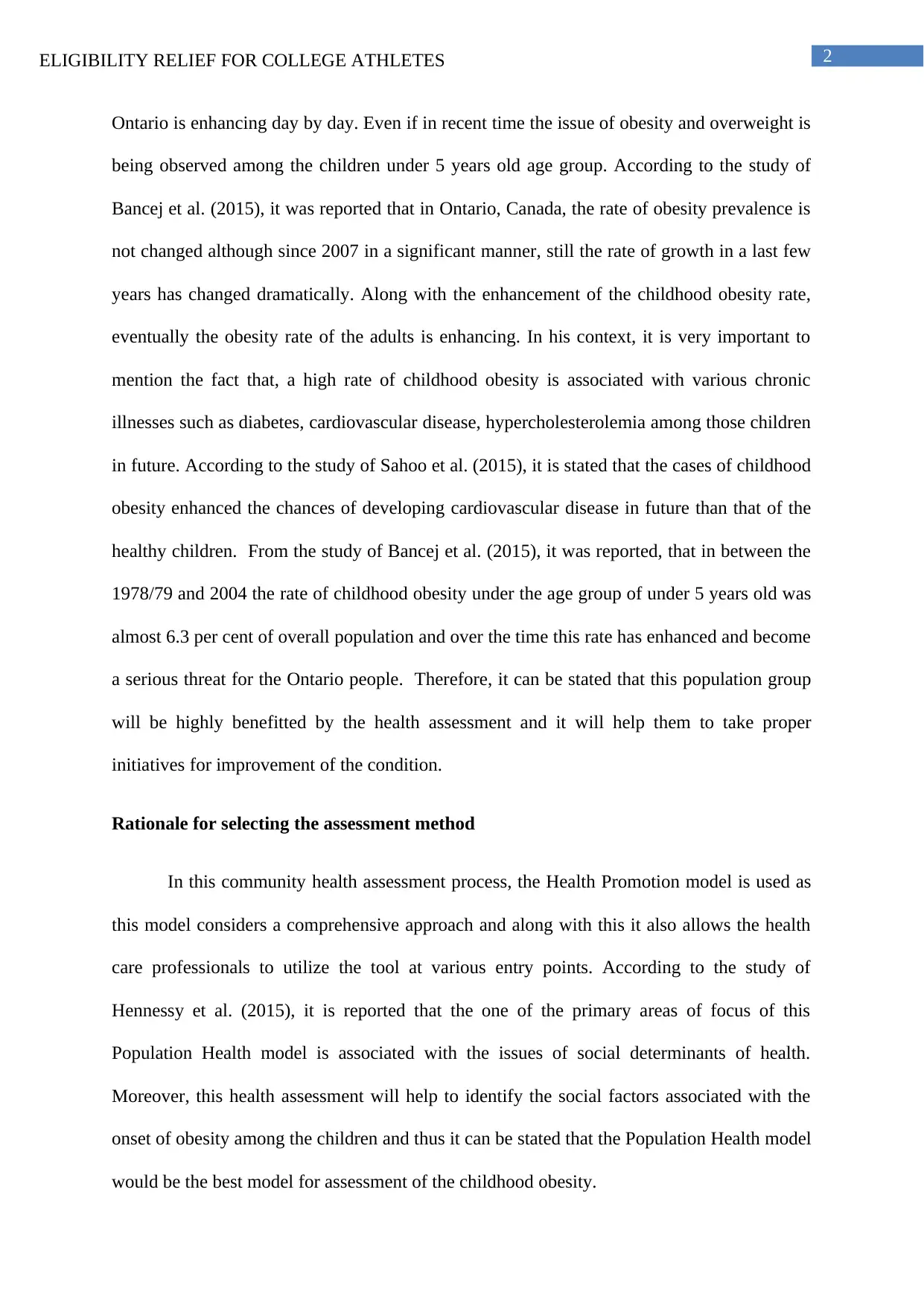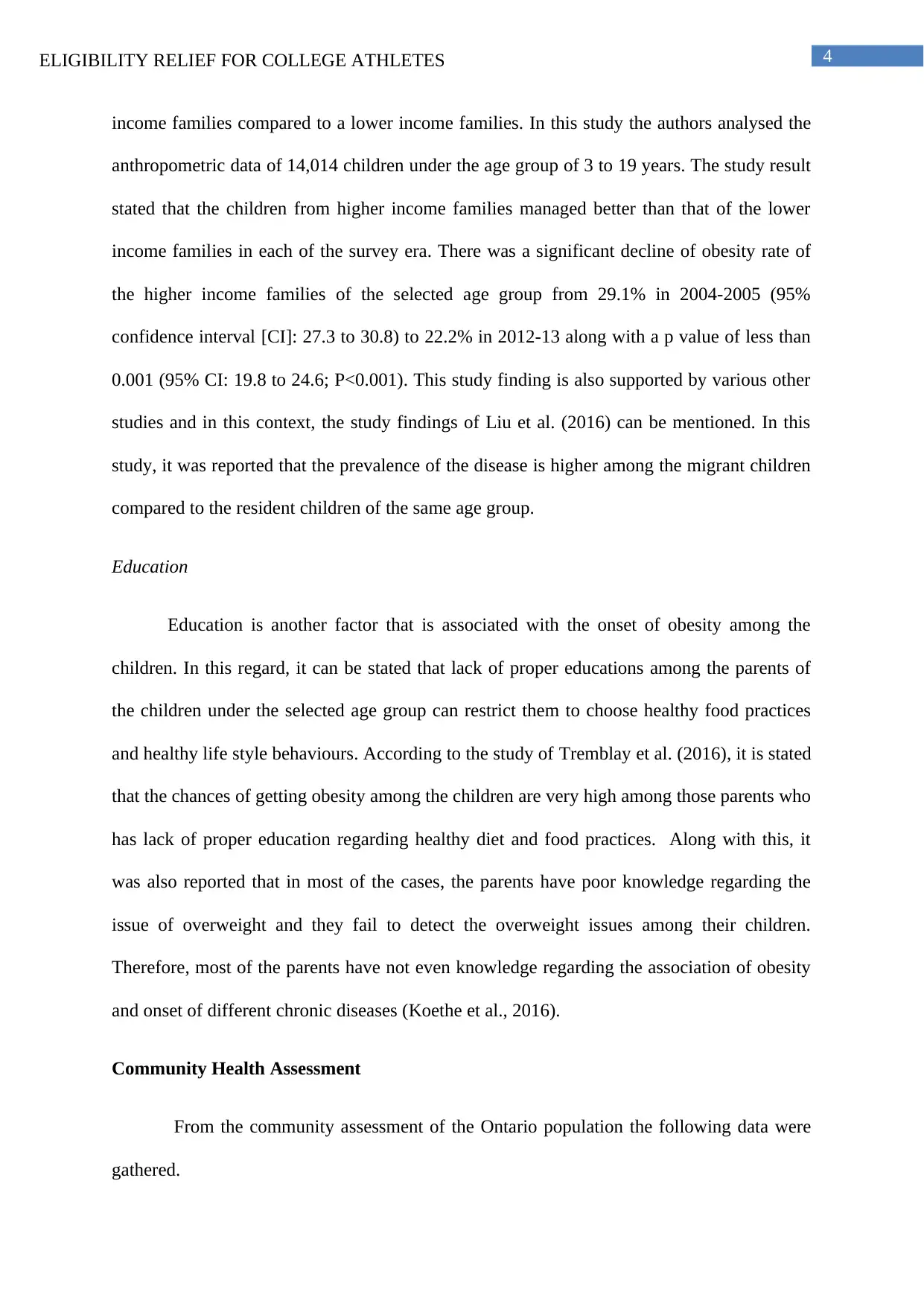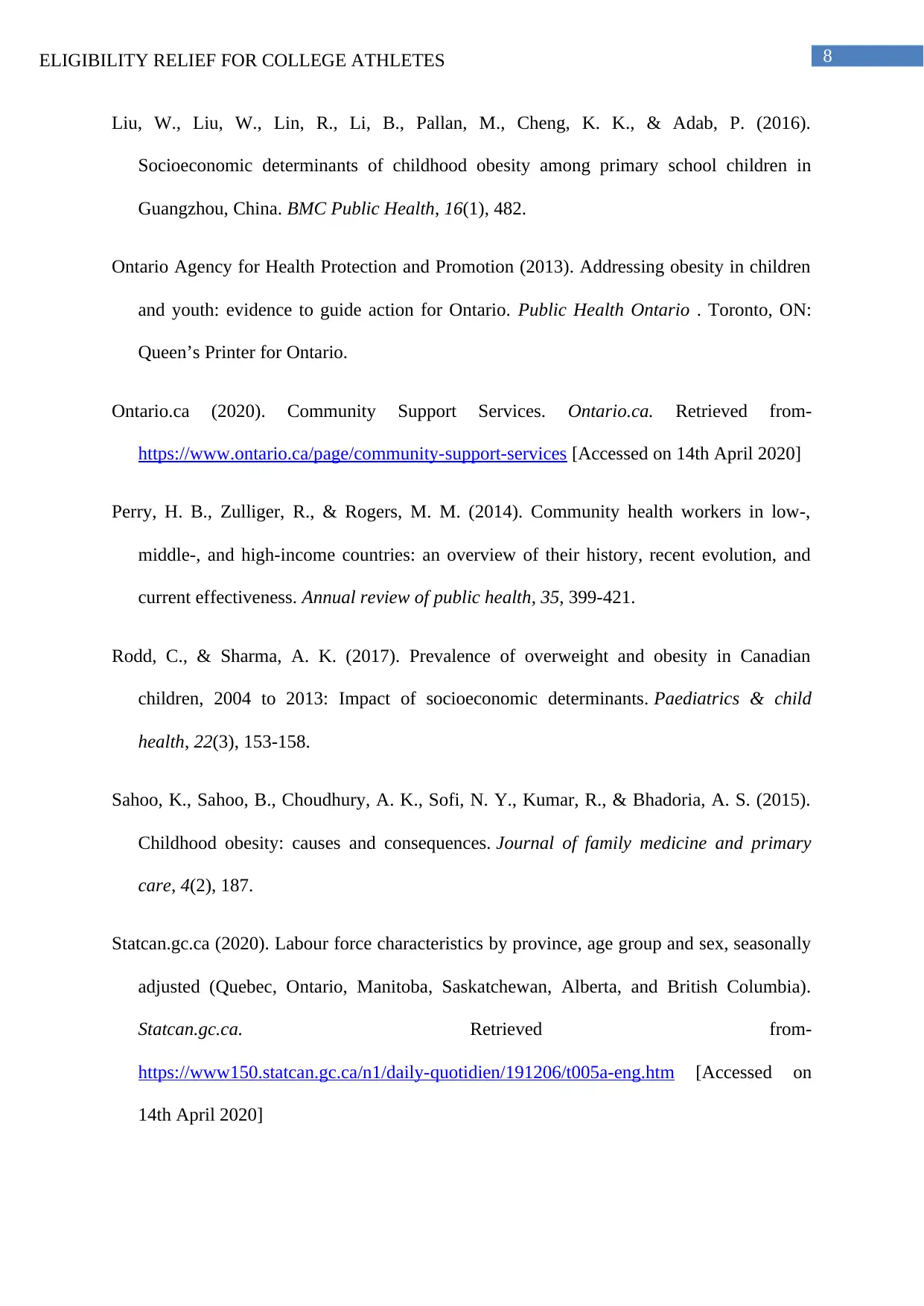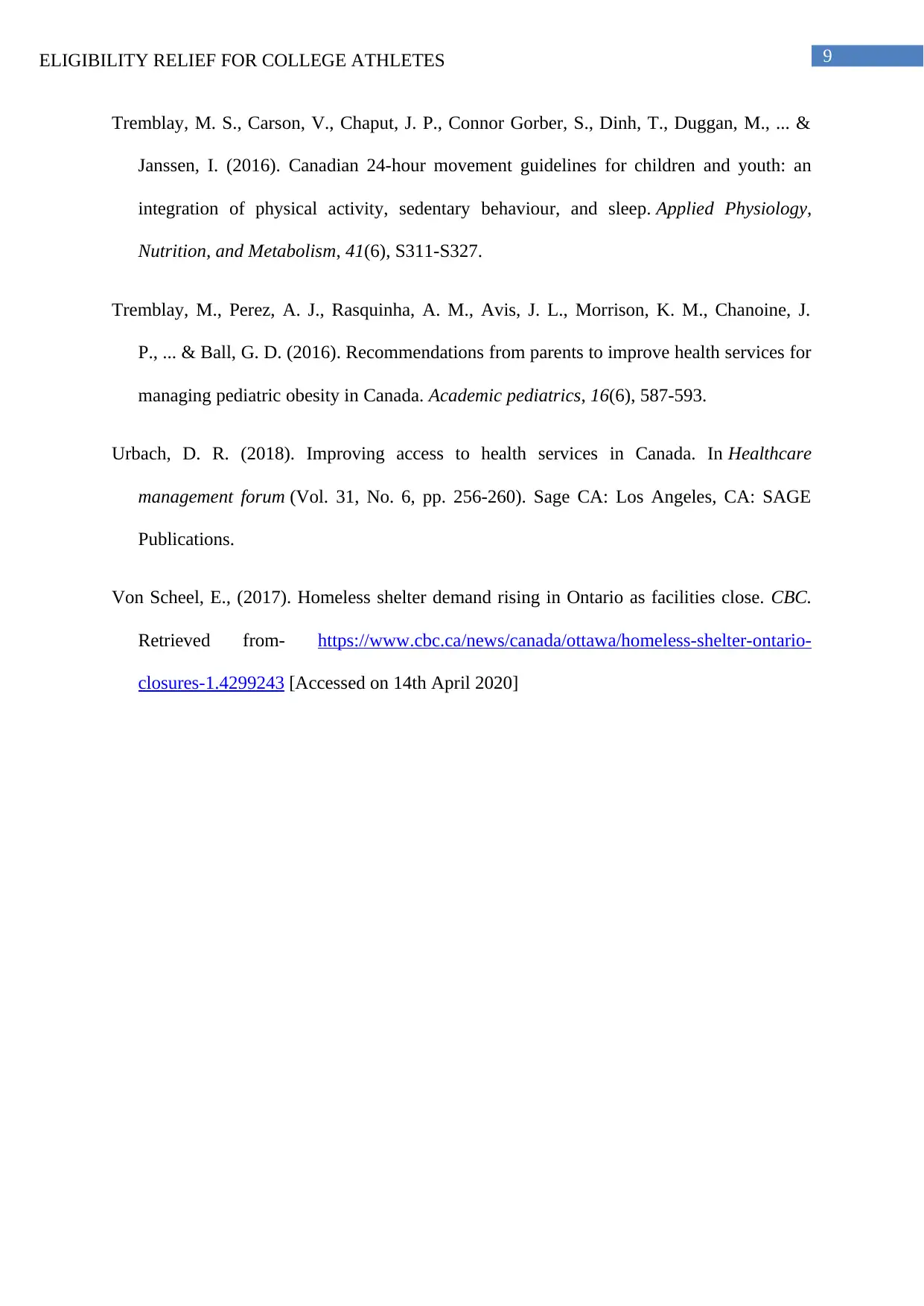NURS 434: Partial Community Health Assessment - Childhood Obesity
VerifiedAdded on 2022/09/17
|10
|2869
|16
Report
AI Summary
This report presents a community health assessment focused on childhood obesity in Ontario, Canada, targeting children under five years old. It identifies the population at risk and provides a rationale for selecting the Health Promotion model, emphasizing its comprehensive approach and focus on social determinants of health. Key social determinants, including physical activity, poverty, and education, are analyzed for their impact on childhood obesity. The assessment incorporates data on population size, employment rates, education levels, community support services, healthcare accessibility, and homelessness in Ontario. Based on the assessment, recommendations are made to improve community health, such as government-subsidized healthy foods, awareness programs, physical activity initiatives, and workshops for parents. The report concludes that childhood obesity is a significant threat, influenced by socioeconomic status, parental education, and lack of physical activity.

Running head: ELIGIBILITY RELIEF FOR COLLEGE ATHLETES
Obesity Assessment in Ontario
Name of the Student
Name of the University
Author Note
Obesity Assessment in Ontario
Name of the Student
Name of the University
Author Note
Paraphrase This Document
Need a fresh take? Get an instant paraphrase of this document with our AI Paraphraser

1ELIGIBILITY RELIEF FOR COLLEGE ATHLETES
Introduction
The issue of community assessment is very crucial for the health condition improvements of
a particular community of a specific area. Moreover, assessment of the community health can
help to identify the needs related to the health and along with this also helps to detect the
social determinants of the health condition of the community people. As a community health
nurse, it is the duty of the individual to complete the assessment and to provide interventions
after identifying the problems of the community in order to improve the overall health
condition (Ontario Agency for Health Protection and Promotion, 2013). From a recent report,
it was reported that in Canada, the issue of obesity has become a serious health related
threats. Specifically in Ontario, it is stated that the almost 70 per cent of the population will
be obese or overweight by the end of 2040. According to the report of Rodd and Sharma
(2017), it was reported that in Canada, the rate of childhood obesity was a serious threats to
the health system of the country as one-third of the Canadian Children and youths are
overweight and obese in present time.
In this essay, a community assessment is discussed for the children of Ontario under
the age group of 5 years and along with this social determinants of health and a few
community diagnosis methods are also discussed.
Identifying the population
In order to conduct the health assessment, firstly it is very important to identify the
target population for this particular community health assessment program (Perry, Zulliger,
& Rogers, 2014). According to the study of Davison et al. (2013), it is stated that the proper
identification of the target population prior to the onset of assessment program is associated
with the success of the community health assessment program. Therefore, from various
reports, it was reported that the rate of obesity among the children in Canada, specifically in
Introduction
The issue of community assessment is very crucial for the health condition improvements of
a particular community of a specific area. Moreover, assessment of the community health can
help to identify the needs related to the health and along with this also helps to detect the
social determinants of the health condition of the community people. As a community health
nurse, it is the duty of the individual to complete the assessment and to provide interventions
after identifying the problems of the community in order to improve the overall health
condition (Ontario Agency for Health Protection and Promotion, 2013). From a recent report,
it was reported that in Canada, the issue of obesity has become a serious health related
threats. Specifically in Ontario, it is stated that the almost 70 per cent of the population will
be obese or overweight by the end of 2040. According to the report of Rodd and Sharma
(2017), it was reported that in Canada, the rate of childhood obesity was a serious threats to
the health system of the country as one-third of the Canadian Children and youths are
overweight and obese in present time.
In this essay, a community assessment is discussed for the children of Ontario under
the age group of 5 years and along with this social determinants of health and a few
community diagnosis methods are also discussed.
Identifying the population
In order to conduct the health assessment, firstly it is very important to identify the
target population for this particular community health assessment program (Perry, Zulliger,
& Rogers, 2014). According to the study of Davison et al. (2013), it is stated that the proper
identification of the target population prior to the onset of assessment program is associated
with the success of the community health assessment program. Therefore, from various
reports, it was reported that the rate of obesity among the children in Canada, specifically in

2ELIGIBILITY RELIEF FOR COLLEGE ATHLETES
Ontario is enhancing day by day. Even if in recent time the issue of obesity and overweight is
being observed among the children under 5 years old age group. According to the study of
Bancej et al. (2015), it was reported that in Ontario, Canada, the rate of obesity prevalence is
not changed although since 2007 in a significant manner, still the rate of growth in a last few
years has changed dramatically. Along with the enhancement of the childhood obesity rate,
eventually the obesity rate of the adults is enhancing. In his context, it is very important to
mention the fact that, a high rate of childhood obesity is associated with various chronic
illnesses such as diabetes, cardiovascular disease, hypercholesterolemia among those children
in future. According to the study of Sahoo et al. (2015), it is stated that the cases of childhood
obesity enhanced the chances of developing cardiovascular disease in future than that of the
healthy children. From the study of Bancej et al. (2015), it was reported, that in between the
1978/79 and 2004 the rate of childhood obesity under the age group of under 5 years old was
almost 6.3 per cent of overall population and over the time this rate has enhanced and become
a serious threat for the Ontario people. Therefore, it can be stated that this population group
will be highly benefitted by the health assessment and it will help them to take proper
initiatives for improvement of the condition.
Rationale for selecting the assessment method
In this community health assessment process, the Health Promotion model is used as
this model considers a comprehensive approach and along with this it also allows the health
care professionals to utilize the tool at various entry points. According to the study of
Hennessy et al. (2015), it is reported that the one of the primary areas of focus of this
Population Health model is associated with the issues of social determinants of health.
Moreover, this health assessment will help to identify the social factors associated with the
onset of obesity among the children and thus it can be stated that the Population Health model
would be the best model for assessment of the childhood obesity.
Ontario is enhancing day by day. Even if in recent time the issue of obesity and overweight is
being observed among the children under 5 years old age group. According to the study of
Bancej et al. (2015), it was reported that in Ontario, Canada, the rate of obesity prevalence is
not changed although since 2007 in a significant manner, still the rate of growth in a last few
years has changed dramatically. Along with the enhancement of the childhood obesity rate,
eventually the obesity rate of the adults is enhancing. In his context, it is very important to
mention the fact that, a high rate of childhood obesity is associated with various chronic
illnesses such as diabetes, cardiovascular disease, hypercholesterolemia among those children
in future. According to the study of Sahoo et al. (2015), it is stated that the cases of childhood
obesity enhanced the chances of developing cardiovascular disease in future than that of the
healthy children. From the study of Bancej et al. (2015), it was reported, that in between the
1978/79 and 2004 the rate of childhood obesity under the age group of under 5 years old was
almost 6.3 per cent of overall population and over the time this rate has enhanced and become
a serious threat for the Ontario people. Therefore, it can be stated that this population group
will be highly benefitted by the health assessment and it will help them to take proper
initiatives for improvement of the condition.
Rationale for selecting the assessment method
In this community health assessment process, the Health Promotion model is used as
this model considers a comprehensive approach and along with this it also allows the health
care professionals to utilize the tool at various entry points. According to the study of
Hennessy et al. (2015), it is reported that the one of the primary areas of focus of this
Population Health model is associated with the issues of social determinants of health.
Moreover, this health assessment will help to identify the social factors associated with the
onset of obesity among the children and thus it can be stated that the Population Health model
would be the best model for assessment of the childhood obesity.
⊘ This is a preview!⊘
Do you want full access?
Subscribe today to unlock all pages.

Trusted by 1+ million students worldwide

3ELIGIBILITY RELIEF FOR COLLEGE ATHLETES
Social Determinants of Health
While discussing about the social determinants of the health related to the onset of
obesity among the children, it can be stated that there are a few factors that can contribute to
the onset of this condition. They are mainly as follows-
Physical Activity
Physical activity is one of the primary social determinants of health for the onset
obesity among the children of Canada. According to the report of Government of Canada, it
can be stated that there is an inverse relationship in between the prevalence of obesity and
leisure time physical activity (LPTA). Most of the data set reported that most of the Canadian
children do not have adequate amount of physical activities as a part of their activities of
daily life and it was reported that during the time period of 2007-09 almost 88 per cent of the
children did not meet the guidelines of National Physical Activity Guide (Government of
Canada, 2020). According to the study of Tremblay et al. (2016), it is stated that the lack of
physical activities is associated with the onset of obesity among the children compared to
those children who are physically active and perform various outdoor games. Therefore, it
can be reported that the issue of poor physical activity is one of the determinants of the
obesity among the children.
Poverty
Another crucial social determinant of health is associated with the economic status of
the family members of the children and in Canadian family, it is stated that poor economic
conditions of the family is associated with the onset of obesity among the children of those
families. According to the study of Rodd and Sharma (2017), it was reported that the rates of
obesity and overweight among the children are lower in the Canadian children from higher
Social Determinants of Health
While discussing about the social determinants of the health related to the onset of
obesity among the children, it can be stated that there are a few factors that can contribute to
the onset of this condition. They are mainly as follows-
Physical Activity
Physical activity is one of the primary social determinants of health for the onset
obesity among the children of Canada. According to the report of Government of Canada, it
can be stated that there is an inverse relationship in between the prevalence of obesity and
leisure time physical activity (LPTA). Most of the data set reported that most of the Canadian
children do not have adequate amount of physical activities as a part of their activities of
daily life and it was reported that during the time period of 2007-09 almost 88 per cent of the
children did not meet the guidelines of National Physical Activity Guide (Government of
Canada, 2020). According to the study of Tremblay et al. (2016), it is stated that the lack of
physical activities is associated with the onset of obesity among the children compared to
those children who are physically active and perform various outdoor games. Therefore, it
can be reported that the issue of poor physical activity is one of the determinants of the
obesity among the children.
Poverty
Another crucial social determinant of health is associated with the economic status of
the family members of the children and in Canadian family, it is stated that poor economic
conditions of the family is associated with the onset of obesity among the children of those
families. According to the study of Rodd and Sharma (2017), it was reported that the rates of
obesity and overweight among the children are lower in the Canadian children from higher
Paraphrase This Document
Need a fresh take? Get an instant paraphrase of this document with our AI Paraphraser

4ELIGIBILITY RELIEF FOR COLLEGE ATHLETES
income families compared to a lower income families. In this study the authors analysed the
anthropometric data of 14,014 children under the age group of 3 to 19 years. The study result
stated that the children from higher income families managed better than that of the lower
income families in each of the survey era. There was a significant decline of obesity rate of
the higher income families of the selected age group from 29.1% in 2004-2005 (95%
confidence interval [CI]: 27.3 to 30.8) to 22.2% in 2012-13 along with a p value of less than
0.001 (95% CI: 19.8 to 24.6; P<0.001). This study finding is also supported by various other
studies and in this context, the study findings of Liu et al. (2016) can be mentioned. In this
study, it was reported that the prevalence of the disease is higher among the migrant children
compared to the resident children of the same age group.
Education
Education is another factor that is associated with the onset of obesity among the
children. In this regard, it can be stated that lack of proper educations among the parents of
the children under the selected age group can restrict them to choose healthy food practices
and healthy life style behaviours. According to the study of Tremblay et al. (2016), it is stated
that the chances of getting obesity among the children are very high among those parents who
has lack of proper education regarding healthy diet and food practices. Along with this, it
was also reported that in most of the cases, the parents have poor knowledge regarding the
issue of overweight and they fail to detect the overweight issues among their children.
Therefore, most of the parents have not even knowledge regarding the association of obesity
and onset of different chronic diseases (Koethe et al., 2016).
Community Health Assessment
From the community assessment of the Ontario population the following data were
gathered.
income families compared to a lower income families. In this study the authors analysed the
anthropometric data of 14,014 children under the age group of 3 to 19 years. The study result
stated that the children from higher income families managed better than that of the lower
income families in each of the survey era. There was a significant decline of obesity rate of
the higher income families of the selected age group from 29.1% in 2004-2005 (95%
confidence interval [CI]: 27.3 to 30.8) to 22.2% in 2012-13 along with a p value of less than
0.001 (95% CI: 19.8 to 24.6; P<0.001). This study finding is also supported by various other
studies and in this context, the study findings of Liu et al. (2016) can be mentioned. In this
study, it was reported that the prevalence of the disease is higher among the migrant children
compared to the resident children of the same age group.
Education
Education is another factor that is associated with the onset of obesity among the
children. In this regard, it can be stated that lack of proper educations among the parents of
the children under the selected age group can restrict them to choose healthy food practices
and healthy life style behaviours. According to the study of Tremblay et al. (2016), it is stated
that the chances of getting obesity among the children are very high among those parents who
has lack of proper education regarding healthy diet and food practices. Along with this, it
was also reported that in most of the cases, the parents have poor knowledge regarding the
issue of overweight and they fail to detect the overweight issues among their children.
Therefore, most of the parents have not even knowledge regarding the association of obesity
and onset of different chronic diseases (Koethe et al., 2016).
Community Health Assessment
From the community assessment of the Ontario population the following data were
gathered.

5ELIGIBILITY RELIEF FOR COLLEGE ATHLETES
1) Total population of the Ontario province is almost 13.6 million and among them a huge
number of population under the selected age group is obese or overweight (Ontario Agency
for Health Protection and Promotion, 2013).
2) While discussing about the status of employment in Ontario, it can be observed that the
rate of overall unemployment is a serious area of concern as the issue of socioeconomic
status of the people is directly associated with the onset of obesity among the people. Under
the age group of 15 -24 year the unemployment rate was changed almost 9.7 per cent from
2018 to 2019. In case of the overall country, the overall rate of unemployment is almost 5.9
per cent in the year of 2017 (Statcan.gc.ca, 2020).
3) From the fact sheets of the Canadian Government, it was reported that the overall
education status among the children is improving over the years and total number of school
enrolment is almost 1377, 162 in elementary schools (Edu.gon.on.ca, 2020).
4) According to the information of Ontario local government, it is reported that the most of
the community support services are delivered free and all the community people need to book
an appoint to visit and it requires referral from a Local Health Integration Network (LHIN)
(Ontario.ca, 2020).
5) While discussing about the health care accessibility, it is reported that most of the services
are easily accessible to the most of the people and about 71 per cent of the people did not
report any problems regarding the accessibility of the services (Urbach, 2018).
6) From the recent report of von Scheel (2017), it was reported that due to the poor economic
status, almost 12,000 Ontarians were facing homelessness in each night. This issue is also
associated with the poor health outcome as it may promote obesity due to unhealthy lifestyle.
Community Diagnosis
1) Total population of the Ontario province is almost 13.6 million and among them a huge
number of population under the selected age group is obese or overweight (Ontario Agency
for Health Protection and Promotion, 2013).
2) While discussing about the status of employment in Ontario, it can be observed that the
rate of overall unemployment is a serious area of concern as the issue of socioeconomic
status of the people is directly associated with the onset of obesity among the people. Under
the age group of 15 -24 year the unemployment rate was changed almost 9.7 per cent from
2018 to 2019. In case of the overall country, the overall rate of unemployment is almost 5.9
per cent in the year of 2017 (Statcan.gc.ca, 2020).
3) From the fact sheets of the Canadian Government, it was reported that the overall
education status among the children is improving over the years and total number of school
enrolment is almost 1377, 162 in elementary schools (Edu.gon.on.ca, 2020).
4) According to the information of Ontario local government, it is reported that the most of
the community support services are delivered free and all the community people need to book
an appoint to visit and it requires referral from a Local Health Integration Network (LHIN)
(Ontario.ca, 2020).
5) While discussing about the health care accessibility, it is reported that most of the services
are easily accessible to the most of the people and about 71 per cent of the people did not
report any problems regarding the accessibility of the services (Urbach, 2018).
6) From the recent report of von Scheel (2017), it was reported that due to the poor economic
status, almost 12,000 Ontarians were facing homelessness in each night. This issue is also
associated with the poor health outcome as it may promote obesity due to unhealthy lifestyle.
Community Diagnosis
⊘ This is a preview!⊘
Do you want full access?
Subscribe today to unlock all pages.

Trusted by 1+ million students worldwide

6ELIGIBILITY RELIEF FOR COLLEGE ATHLETES
From the above assessments of the community health, a few recommendations can be
made to improve the condition of the community and they are as follows-
Government should supply healthy foods in a subsidized rate so that everyone can
access healthy foods.
Awareness program on obesity and overweight should be launched for the community
people.
Physical activity program should be launched focussing on the specific age group of
the community.
Workshops on healthy living practices can be arranged so that parents can identify the
risks of obesity and overweight among their children.
Conclusion
Hence, it can be concluded that the issue of childhood obesity is a serious threats for
the children of Ontario like other part of Canada and day by day the percentage of childhood
obesity is also enhancing and in this regard, it can be stated that there are various factors such
as lower socio economic status, low level of education among the parents and lack of
physical activity practices can contribute to the onset of obesity among the children.
From the above assessments of the community health, a few recommendations can be
made to improve the condition of the community and they are as follows-
Government should supply healthy foods in a subsidized rate so that everyone can
access healthy foods.
Awareness program on obesity and overweight should be launched for the community
people.
Physical activity program should be launched focussing on the specific age group of
the community.
Workshops on healthy living practices can be arranged so that parents can identify the
risks of obesity and overweight among their children.
Conclusion
Hence, it can be concluded that the issue of childhood obesity is a serious threats for
the children of Ontario like other part of Canada and day by day the percentage of childhood
obesity is also enhancing and in this regard, it can be stated that there are various factors such
as lower socio economic status, low level of education among the parents and lack of
physical activity practices can contribute to the onset of obesity among the children.
Paraphrase This Document
Need a fresh take? Get an instant paraphrase of this document with our AI Paraphraser

7ELIGIBILITY RELIEF FOR COLLEGE ATHLETES
References
Bancej, C., Jayabalasingham, B., Wall, R. W., Rao, D. P., Do, M. T., De Groh, M., &
Jayaraman, G. C. (2015). Trends and projections of obesity among Canadians. Health
promotion and chronic disease prevention in Canada: research, policy and
practice, 35(7), 109.
Davison, K. K., Jurkowski, J. M., Li, K., Kranz, S., & Lawson, H. A. (2013). A childhood
obesity intervention developed by families for families: results from a pilot
study. International Journal of Behavioral Nutrition and Physical Activity, 10(1), 3.
Edu.gon.on.ca (2020). Quick Facts: Ontario Schools 2016-17. Ministry of Education.
Retrieved from-
http://www.edu.gov.on.ca/eng/general/elemsec/quickfacts/2016_2017.html [Accessed on
14th April 2020]
Government of Canada (2020). Obesity in Canada – Determinants and contributing factors.
Government of Canada. Retrieved from-
https://www.canada.ca/en/public-health/services/health-promotion/healthy-living/obesity-
canada/factors.html [Accessed on 14th April 2020]
Hennessy, D. A., Flanagan, W. M., Tanuseputro, P., Bennett, C., Tuna, M., Kopec, J., ... &
Manuel, D. G. (2015). The Population Health Model (POHEM): an overview of rationale,
methods and applications. Population health metrics, 13(1), 24.
Koethe, J. R., Jenkins, C. A., Lau, B., Shepherd, B. E., Justice, A. C., Tate, J. P., ... &
Blashill, A. J. (2016). Rising obesity prevalence and weight gain among adults starting
antiretroviral therapy in the United States and Canada. AIDS research and human
retroviruses, 32(1), 50-58.
References
Bancej, C., Jayabalasingham, B., Wall, R. W., Rao, D. P., Do, M. T., De Groh, M., &
Jayaraman, G. C. (2015). Trends and projections of obesity among Canadians. Health
promotion and chronic disease prevention in Canada: research, policy and
practice, 35(7), 109.
Davison, K. K., Jurkowski, J. M., Li, K., Kranz, S., & Lawson, H. A. (2013). A childhood
obesity intervention developed by families for families: results from a pilot
study. International Journal of Behavioral Nutrition and Physical Activity, 10(1), 3.
Edu.gon.on.ca (2020). Quick Facts: Ontario Schools 2016-17. Ministry of Education.
Retrieved from-
http://www.edu.gov.on.ca/eng/general/elemsec/quickfacts/2016_2017.html [Accessed on
14th April 2020]
Government of Canada (2020). Obesity in Canada – Determinants and contributing factors.
Government of Canada. Retrieved from-
https://www.canada.ca/en/public-health/services/health-promotion/healthy-living/obesity-
canada/factors.html [Accessed on 14th April 2020]
Hennessy, D. A., Flanagan, W. M., Tanuseputro, P., Bennett, C., Tuna, M., Kopec, J., ... &
Manuel, D. G. (2015). The Population Health Model (POHEM): an overview of rationale,
methods and applications. Population health metrics, 13(1), 24.
Koethe, J. R., Jenkins, C. A., Lau, B., Shepherd, B. E., Justice, A. C., Tate, J. P., ... &
Blashill, A. J. (2016). Rising obesity prevalence and weight gain among adults starting
antiretroviral therapy in the United States and Canada. AIDS research and human
retroviruses, 32(1), 50-58.

8ELIGIBILITY RELIEF FOR COLLEGE ATHLETES
Liu, W., Liu, W., Lin, R., Li, B., Pallan, M., Cheng, K. K., & Adab, P. (2016).
Socioeconomic determinants of childhood obesity among primary school children in
Guangzhou, China. BMC Public Health, 16(1), 482.
Ontario Agency for Health Protection and Promotion (2013). Addressing obesity in children
and youth: evidence to guide action for Ontario. Public Health Ontario . Toronto, ON:
Queen’s Printer for Ontario.
Ontario.ca (2020). Community Support Services. Ontario.ca. Retrieved from-
https://www.ontario.ca/page/community-support-services [Accessed on 14th April 2020]
Perry, H. B., Zulliger, R., & Rogers, M. M. (2014). Community health workers in low-,
middle-, and high-income countries: an overview of their history, recent evolution, and
current effectiveness. Annual review of public health, 35, 399-421.
Rodd, C., & Sharma, A. K. (2017). Prevalence of overweight and obesity in Canadian
children, 2004 to 2013: Impact of socioeconomic determinants. Paediatrics & child
health, 22(3), 153-158.
Sahoo, K., Sahoo, B., Choudhury, A. K., Sofi, N. Y., Kumar, R., & Bhadoria, A. S. (2015).
Childhood obesity: causes and consequences. Journal of family medicine and primary
care, 4(2), 187.
Statcan.gc.ca (2020). Labour force characteristics by province, age group and sex, seasonally
adjusted (Quebec, Ontario, Manitoba, Saskatchewan, Alberta, and British Columbia).
Statcan.gc.ca. Retrieved from-
https://www150.statcan.gc.ca/n1/daily-quotidien/191206/t005a-eng.htm [Accessed on
14th April 2020]
Liu, W., Liu, W., Lin, R., Li, B., Pallan, M., Cheng, K. K., & Adab, P. (2016).
Socioeconomic determinants of childhood obesity among primary school children in
Guangzhou, China. BMC Public Health, 16(1), 482.
Ontario Agency for Health Protection and Promotion (2013). Addressing obesity in children
and youth: evidence to guide action for Ontario. Public Health Ontario . Toronto, ON:
Queen’s Printer for Ontario.
Ontario.ca (2020). Community Support Services. Ontario.ca. Retrieved from-
https://www.ontario.ca/page/community-support-services [Accessed on 14th April 2020]
Perry, H. B., Zulliger, R., & Rogers, M. M. (2014). Community health workers in low-,
middle-, and high-income countries: an overview of their history, recent evolution, and
current effectiveness. Annual review of public health, 35, 399-421.
Rodd, C., & Sharma, A. K. (2017). Prevalence of overweight and obesity in Canadian
children, 2004 to 2013: Impact of socioeconomic determinants. Paediatrics & child
health, 22(3), 153-158.
Sahoo, K., Sahoo, B., Choudhury, A. K., Sofi, N. Y., Kumar, R., & Bhadoria, A. S. (2015).
Childhood obesity: causes and consequences. Journal of family medicine and primary
care, 4(2), 187.
Statcan.gc.ca (2020). Labour force characteristics by province, age group and sex, seasonally
adjusted (Quebec, Ontario, Manitoba, Saskatchewan, Alberta, and British Columbia).
Statcan.gc.ca. Retrieved from-
https://www150.statcan.gc.ca/n1/daily-quotidien/191206/t005a-eng.htm [Accessed on
14th April 2020]
⊘ This is a preview!⊘
Do you want full access?
Subscribe today to unlock all pages.

Trusted by 1+ million students worldwide

9ELIGIBILITY RELIEF FOR COLLEGE ATHLETES
Tremblay, M. S., Carson, V., Chaput, J. P., Connor Gorber, S., Dinh, T., Duggan, M., ... &
Janssen, I. (2016). Canadian 24-hour movement guidelines for children and youth: an
integration of physical activity, sedentary behaviour, and sleep. Applied Physiology,
Nutrition, and Metabolism, 41(6), S311-S327.
Tremblay, M., Perez, A. J., Rasquinha, A. M., Avis, J. L., Morrison, K. M., Chanoine, J.
P., ... & Ball, G. D. (2016). Recommendations from parents to improve health services for
managing pediatric obesity in Canada. Academic pediatrics, 16(6), 587-593.
Urbach, D. R. (2018). Improving access to health services in Canada. In Healthcare
management forum (Vol. 31, No. 6, pp. 256-260). Sage CA: Los Angeles, CA: SAGE
Publications.
Von Scheel, E., (2017). Homeless shelter demand rising in Ontario as facilities close. CBC.
Retrieved from- https://www.cbc.ca/news/canada/ottawa/homeless-shelter-ontario-
closures-1.4299243 [Accessed on 14th April 2020]
Tremblay, M. S., Carson, V., Chaput, J. P., Connor Gorber, S., Dinh, T., Duggan, M., ... &
Janssen, I. (2016). Canadian 24-hour movement guidelines for children and youth: an
integration of physical activity, sedentary behaviour, and sleep. Applied Physiology,
Nutrition, and Metabolism, 41(6), S311-S327.
Tremblay, M., Perez, A. J., Rasquinha, A. M., Avis, J. L., Morrison, K. M., Chanoine, J.
P., ... & Ball, G. D. (2016). Recommendations from parents to improve health services for
managing pediatric obesity in Canada. Academic pediatrics, 16(6), 587-593.
Urbach, D. R. (2018). Improving access to health services in Canada. In Healthcare
management forum (Vol. 31, No. 6, pp. 256-260). Sage CA: Los Angeles, CA: SAGE
Publications.
Von Scheel, E., (2017). Homeless shelter demand rising in Ontario as facilities close. CBC.
Retrieved from- https://www.cbc.ca/news/canada/ottawa/homeless-shelter-ontario-
closures-1.4299243 [Accessed on 14th April 2020]
1 out of 10
Related Documents
Your All-in-One AI-Powered Toolkit for Academic Success.
+13062052269
info@desklib.com
Available 24*7 on WhatsApp / Email
![[object Object]](/_next/static/media/star-bottom.7253800d.svg)
Unlock your academic potential
Copyright © 2020–2025 A2Z Services. All Rights Reserved. Developed and managed by ZUCOL.





